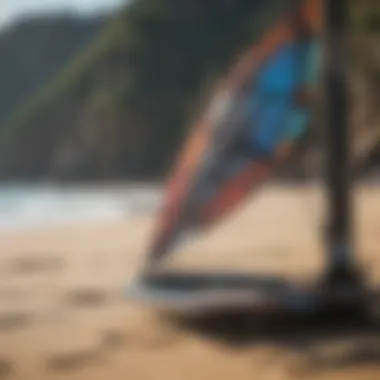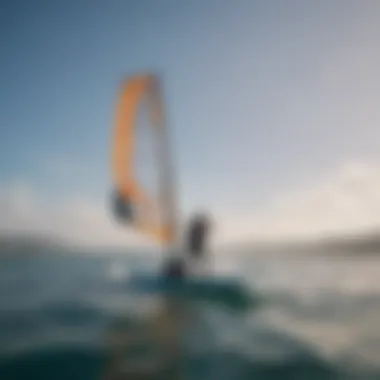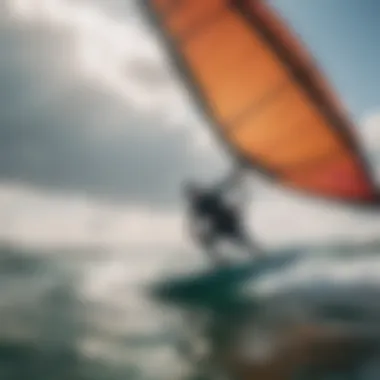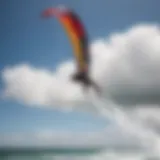The Financial Landscape of Wing Foiling Unveiled


Intro
Wing foiling has gained significant attention in recent years, captivating both beginners and seasoned enthusiasts. However, the cost associated with entering this sport can be a concern for many. Whether you are just starting or looking to upgrade your gear, understanding the financial implications of wing foiling equipment is crucial. This section will analyze various component costs and reveal how the market influences pricing decisions. Identifying the right options will not only save you money, but also enhance your performance on the water.
Equipment Reviews
Kites
Kites are the most important component in wing foiling, creating the power necessary to ride effectively. Today's market offers a wide array of kite models tailored for different skills and preferences. Common materials used include Nylon and Dacron for durability and performance. Most kite models range in sizes, with capacities from 3m² to 12m² or more.
The shapes of kites also vary significantly, ranging from delta wings for stability to bow kites that are user-friendly for novices. Some popular brands among riders include North, Duotone, and Core. Understanding these options helps buyers make informed choices based on their need for performance, durability, and budget.
Boards
The selection of boards enhances your experience and flexibility on the water. Some riders may prefer twintip boards, known to excel in freestyle elements, while others lean towards directional boards suited for wave riding.
When comparing the designs, you'll discover aspects like outline shape, concave, and rocker play vital roles in how the board performs. Board construction typically utilizes a blend of foam and fiberglass, impacting the weight and buoyancy in the water. Price ranges widely, with budget-friendly options available alongside high-end, performance-enhancing models.
Accessories
Essential accessories can enhance safety and comfort. Harnesses are crucial for support, allowing full maneuverability while ensuring load distribution on the rider’s body. Lines made from Dyneema or Polyester are common in various lengths, designed to match specific kite sizes for optimum performance.
Pumps are necessary tools, and investing in a quality option speeds up setup time. Buyers should consider safety gear, such as helmets and life jackets, to mitigate risks. Understanding the functions and necessity of each accessory aids in building a comprehensive kit while optimizing your investment.
Investing in quality equipment is essential for kindly enduring your experience in wing foiling.
Travel Destinations
Popular Spots
Certain destinations are celebrated among wing foiling practitioners due to their optimal wind and water conditions. Locations like Cabarete in the Dominican Republic and Leuco in Egypt stand out for their dependable winds and third-class beaches. Local amenities related to tourism are often available, making these destinations more accessible for enthusiasts.
Off the Beaten Path
Hidden gems exist around the world, offering unique wing foiling experiences. Islands like Gili Air in Indonesia or beaches in Portugal are lesser-known but provide exceptional conditions for thrill-seekers. These underrated spots often allow riders a more laid-back atmosphere compared to crowded labels.
Techniques and Tutorials
Beginner Guides
Newer riders benefit wth beginner guides to grasp essentials like launching and landing. It is crucial to understanding how wind gusts behave and how to manage kites effectively. Step-by-step breakdown often reveals common pitfalls to avoid during practices.
Advanced Skills
Experienced riders seeking to elevate their skills can focus on learning advanced maneuvers, such as jumps and rotations, essential for expressing creativity and personal style while cruising the coast or chasing waves.
Safety Guidelines
Weather Conditions
Weather can significantly affect wing foiling conditions. Education on good practices regarding currents, tides, and storms is necessary, enabling more confident decisions about being out on water.
Emergency Protocols
Every rider should be familiar with rescue tactics. Knowing how to conduct self-rescue or assist others in various scenarios is crucial for enjoying a safe journey. Moreover, regular equipment checks prove essential before embarking on a trip.
Equipment Maintenance
Frequent maintenance ensures gear longevity and should be a priority for anyone looking to invest significantly in wing foiling equipment. Take necessary time to inspect tension lines, inflatable components, and stitching regularly.
By dissecting each aspect of wing foiling, potential buyers can navigate the Cost of Wing Foiling with clarity regarding their equipment investments. Understanding the interplay of choice, quality, and budget determines an enriched journey into the sport.
Understanding Wing Foiling
Wing foiling combines the dynamics of traditional wind sports with a unique aspect that has attracted a growing community of enthusiasts. This sport employs a wing, a board, and a hydrofoil that allows the rider to glide above the surface of the water. Understanding wing foiling involves delving into the specific components required, each contributing to the performance and experience of the rider. The rise of wing foiling corresponds with its accessibility and the relatively affordable entry point compared to other wind sports like kiteboarding or windsurfing.
Learning the principle behind each component is vital, not only for maximizing performance but also for understanding the associated costs. Having a comprehensive grasp helps in making informed decisions whether a beginner or an experienced rider.


Defining Wing Foiling
Wing foiling can be defined as a wind-powered sport which utilizes a handheld wing to harness the wind's energy, propelling the rider across the water on a specially designed board fitted with a hydrofoil. The essential innovation here is the hydrofoil, which elevates the board above the water, substantially reducing drag. This phenomenon creates smoother surfaces and enhances speeds significantly when compared to traditional surfing or kiting.
The essence of wing foiling lies in its simplicity combined with the thrill it delivers. Riders can attain speed and agility that was not achievable with prior board sports, and the equipment setup is compact. The wing provides precise control and can be used in varying conditions, making it adaptable for various skill levels.
The Equipment Required
Having the right equipment is fundamental to the success and safety of wing foiling. There are four main components required, and each plays a unique role in the wing foiling experience. Here’s a closer examination of each:
Wing
The wing serves as the primary interface between the rider and the wind. Its lightweight construction allows for easy handling, making it a practical choice for users. Common materials include durable nylon and inflatable designs that improve performance through air containment. A key characteristic of wings is their aspect ratio, which impacts lift and maneuverability.
Users experience benefits through improved energy efficiency and easier directional control. However, selecting the right size can also present challenges. A wing that is too large may generate excessive lift in high winds, leading to trouble steering. Conversely, a wing that is too small may not provide adequate power in light winds.
Board
The board is designed to be buoyant and responsive, crucial for initial takeoffs and general handling. Typically shorter and wider than traditional surfboards, these boards allow for better stability during the foiling process. Effective boards may use foam, often sealed in reinforced shells to endure stress and impact.
A notable aspect of boards is the board’s volume, which generally should match the rider's weight for optimal performance. Optimal performance results in easier ascension into the air when starting to foil. However, boards lacking in volume can result in difficulty during take-off.
Foil
The hydrofoil is the keystone invention in wing foiling, enabling the board to lift efficiently above the surface. Various components have been engineered into the foil, including wings and masts crafted from carbon fiber or aluminum for weight reduction.
The design span of a foil impacts speed – longer spans can reach higher velocities but may offer decreased maneuverability. High-quality foils allow better ‘lifting capabilities’ with minimized drag, providing significant advantages especially for competitive riders. That said, higher performance foils often come with heavier price tags due to their sophisticated construction and enhanced technology.
Safety Gear
Safety gear cannot be overlooked in wing foiling. Key items include a personal flotation device, helmet, and impact vest. Each of these contributes directly to reducing risk while engaging with the sport. Certified safety equipment retains certification standards, providing peace of mind to users.
Moreover, quality safety gear supports connection experience and offers reassurance in challenging conditions. Selecting excellent quality gear ensures both protection and improved comfort on the water. While safety gear may seem like an extra expense, it plays an integral part in responsible participation.
Good equipment is an investment that significantly impacts the enjoyment and safety experienced in wing foiling. Better equipment opens opportunities for progression so riders can maximize thrill in all conditions.
Components of Pricing
Understanding the components of pricing is essential for anyone looking to invest in wing foiling equipment. This section outlines various factors that contribute to the overall cost of gear and offers insight into how these elements can impact investment decisions for both newcomers and experienced users. By assessing these components, buyers can make more informed choices and tailor their purchases to meet their specific needs, whether they prioritize budget, performance, or brand selection.
Material Quality
The quality of materials used in wing foiling equipment has a significant influence on price. Higher-grade materials generally provide better performance and durability. For instance, wings may use advanced fabrics, like ripstop nylon or Kevlar, to ensure strength and longevity. These materials are more resistant to tears and wear from regular use. Similarly, boards made from lightweight composites offer easier handling and agility but come at a higher cost.
Factors to consider when evaluating material quality include:
- Durability: Long-lasting equipment reduces the need for constant replacement.
- Performance: Higher-quality materials can improve speed and responsiveness on the water.
- Maintenance: Some materials require more care, affecting overall usage costs over time.
Investing in higher-quality materials can prove beneficial in the long run. Although they have increased initial costs, their superior performance and longer lifespan often justifies the price.
Brand Reputation
Brand reputation plays a crucial role in determining the cost of wing foiling equipment. Established brands, such as Duotone or Slingshot, often command higher prices due to their reputation for quality and performance. This trust builds a sense of assurance for buyers that their investment will lead to reliable performance on the water.
Considerations include:
- Reliability: Renowned brands often provide consistent quality in their products.
- Innovation: Many leading brands invest heavily in R&D to develop cutting-edge technology.
- Customer Support: Well-known brands may offer better warranties and support services.
Enthusiasts might find that spending slightly more on equipment from reputed brands can enhance the overall experience and provide peace of mind.
Technological Innovation
Technological advances in equipment design and materials can significantly sway prices. The development of new techniques in molding and material science helps manufacturers create lighter, stronger, and more efficient products. For instance, innovations such as inflatable wings or modular boards have reshaped the market landscape.
Reasons to value technological innovation include:
- Performance Improvement: Cutting-edge equipment often offers enhanced usability and maneuverability.
- User Experience: New designs might provide users with advancements in handling or launching mechanics.
- Future-proofing: Investing in newer technology can minimize the likelihood of hardware becoming obsolete quickly.


As buyers evaluate the cost of equipment, they should recognize how these innovations play into long-term performance benefits versus upfront costs.
In summary, each component of pricing should be scrutinized to ensure customers make wise purchasing decisions that align with their specific needs and riding style.
Cost Breakdown
The cost breakdown of wing foiling is vital for understanding the financial commitments involved in this sport. Knowing the price range of specific equipment helps both novices and experienced athletes identify their budget and focus on what they need the most. With the variety of equipment and brands on the market, the ability to assess costs accurately can lead to smarter purchasing decisions and better overall satisfaction with one’s gear.
Average Prices for Wings
Wings, essential for the sport, vary significantly in price based on materials, size, and brand. The average price typically ranges between $600 to $1,500. Higher-end options may offer upgraded materials and improved performance features. It’s important to note that choosing a wing suited to individual skill level is paramount for maximizing enjoyment and learning progression.
Consider the following aspects when evaluating wing prices:
- Build Quality: More expensive wings often use durable materials, offering better longevity.
- Size Options: Wings engineered for specific wind conditions may alter costs.
- Brand Influences: Renowned brands charge a premium but typically guarantee quality performance.
Average Prices for Boards
Boards are the second component, and their costs generally fall within the range of $800 to $2,500. The price fluctuates, influenced by size, design, and specialty features like lightweight construction or advanced hydrodynamics. A well-chosen board can substantially improve maneuverability and ease of use for the rider.
As you evaluate board prices, consider:
- Functionality Needs: Different boards adapt for speed, wave riding or freestyle. Choosing one based on intended style of riding is crucial in the buying process.
- Material Selection: The use of quality materials can impact both pricing and performance.
Average Prices for Foils
Foils represent another significant expense in this activity, often ranging from $1,000 to $2,800. Price elements typically correlate with design innovations and performance capabilities. The hydrofoil’s performance is critical as it directly influences the riding experience.
When gauging foil prices, look for:
- Construction Quality: Materials can increase durability and performance under various conditions.
- Technology: Advanced designs may come with a higher cost, emphasizing efficiency and speed.
Cost of Safety Gear
Safety gear, although sometimes overlooked, is fundamental in wing foiling. Typical expenses range from $100 to $500, depending on the complexity and functionality of the gear. Required items include helmets, impact vests, and potentially wetsuits for colder conditions. Ensuring adequate protection is non-negotiable, as it promotes a safer riding experience.
It's prudent to invest in such gear as a reasonable safety level can save on potential medical costs in case of accidents. Look for:
- Comfort Fit: Safety gear must allow freedom of movement, important for optimizing performance.
- Quality Ratings: Opt for recognized brands with reliable safety certifications.
In summary, understanding the cost breakdown of every component of wing foiling equips enthusiasts to make better purchasing decisions and fosters smarter investment in their equipment.
Market Trends in Wing Foiling
Market trends significantly influence the overall cost and availability of wing foiling equipment. Understanding these trends can help consumers make informed decisions when investing in equipment. Many factors play a role, such as innovation in product design, the emergence of new brands, and the industry's response to ecological concerns. This knowledge does not only shape purchasing behavior but also predicts the future landscape of the sport.
Emerging Brands and Innovation
In recent years, a number of emerging brands have made noteworthy impacts on the wing foiling market. These brands focus on producing high-quality products at competitive prices. They employ advanced materials and innovative techniques to enhance performance and durability, making them appealing to both beginners and experienced riders.
Consumers are likely to find it beneficial to explore these new options alongside established brands. Innovative designs often offer advantages, like improved stability and efficiency. Brands such as Lift Foils and Starboard, for instance, continuously refine their products to cater to changing consumer demands.
These newcomers often introduce fresh ideas, which competitors must acknowledge and adapt to. As a result, innovation is not restricted to product development; marketing strategies also shift. Ensuring that equipment meets contemporary styles and formats is crucial for sustaining customer interest.
Sustainability and Eco-Friendly Practices
Recent trends emphasize sustainability in wing foiling equipment. More brands incorporate eco-friendly practices in their production processes. This aspect becomes essential as consumers increasingly prefer to support brands that prioritize the environment.
Materials such as bio-resins, organic textiles, and recyclable components are gaining traction. These provisions not only reduce environmental impact but also cater to an audience that is mindful of ecological footprints.
Furthermore, brands that adopt sustainable practices often build stronger relationships with consumers. Future customers see an essential value in products that do not compromise environmental integrity. Increased expenditure due to eco-friendly innovations may seem detrimental initially; however, long-term benefits and brand loyalty can trump these costs, solidifying a more meaningful connection between brand and consumer.
The overall essence of the sustainability movement within wing foiling is a reflection of broader consumer priorities.
In summary, market trends towards emerging brands and sustainability shape the landscape of wing foiling. A combination of innovation and accountability can influence purchase decisions and steer potential customers while contributing to a positive impact on the environment. Staying abreast of such trends enables consumers to choose wisely and prepares them for future developments in wing foiling.
Considerations for New Buyers


For individuals considering the entry into wing foiling, understanding the associated costs is paramount. Choosing the right equipment can greatly influence both enjoyment and skill development. This section explores key considerations aimed at aiding new buyers to navigate this intricate landscape.
Starting with a Budget
Creating a realistic budget is essential for anyone looking to invest in wing foiling. This sportcan require a significant initial outlay. Aspects to think about at this stage include:ul> li> Essential Equipment: Focus on securing essential items first. These include the wing, board, and foil. While safety gear might not seem necessary at first, it should not be overlooked. li> li> Quality vs. Cost: Often, higher quality equipment contributes to a better experience and can lead to quicker skill acquisition. Balancing quality and budget helps ensure longer-term satisfaction with the purchase. li> li> Used vs. New Gear: For newer enthusiasts, used equipment can prove an excellent way to cut costs. Make sure to verify the condition before purchasing and consider if the seller has suitable knowledge of wing foiling. li> ul>
You should also remember the importance of factor costs that might arise beyond initial purchases, such as travel to various locations for the sport.
Choosing the Right Equipment
Selecting appropriate equipment can seem daunting due to vast options available. However, certain considerations can guide a new buyer:
- Skill Level: Beginners should consider forgiving equipment that enhances learning experiences such as wider boards, which offer better stability.
- Equipment Compatibility: Understand how the different components work together. A well-matched foil and board can substantially impact performance.
- Personal Preferences: Other factors inclde the style of riding one is looking for, recreational use or more intense applications. These desires will evolve skills as time passes.
Ultimately, familiarity with your needs and style can serve as a compass toward selecting the right equipment.
Evaluating Long-Term Costs
New buyers need to anticipate and comprehend long-term costs involved in wing foiling. Beyond the immediate purchase of gear, evaluating ongoing expenses allows better overall sound investment. Considerations include:ul> li> Maintenance and Repairs: Equipment, especially when used with the elements, needs care. Plans on repairs must account for constant support to prolong lifespan of gear. li> li> Accessibility and Travel: Think about how often one intends to travel to locations to practice the sport. Frequent trips accrue costs for transportation, leisure, and lodging. li> li> Store Stock: Keeping up with the newest gear or upgrades impacts long-term finance. Seasons change equipment setups are also optimal for areas suited best. li> ul>
The total investment extends beyond acquisitions and serves as guide and strategy, defining journey for immense experience and skill acquisition overall. By downloading on such aspects, new buyers can navigate wing foiling asynchronously while preserving paticular elements that offer perserverance in sport.
Impact of Equipment Prices on Enthusiasts
The prices for wing foiling equipment can greatly influence how enthusiasts experience the sport. Understanding the economic impact of these costs helps potential buyers make informed decisions. These decisions can affect not only an individual’s budget but also their overall enjoyment and skill development. Consideration of the costs leads to a more meaningful engagement in the sport itself.
Budgeting for Experience
Proper budgeting is crucial for anyone interested in wing foiling. First, you need to consider initial costs, which include purchasing a wing, a board, a foil, and safety gear. Each type of equipment presents different price points. Thus, budgeting methods may differ significantly between newcomers and seasoned riders. Enthusiasts should know the value of budgeting for accessories, maintenance, and equipment upgrades.
Focus areas for budgeting include:
- Initial Equipment Purchase: Look for quality. It can be tempting to choose cheaper brands, but in many cases, cheaper gear can increase long-term costs due to damages or low performance.
- Maintenance Costs: Gear longevity is dependent on maintenance. Repairs can add to overall expenses.
- Experience Costs: Consider travel costs for better spots or workshops to advance skills.
By taking a strategic approach to budgeting, enthusiasts can enhance their experiences significantly and reduce financial stress down the road.
Comparing Cost vs.
Skill Development
When investing in wing foiling equipment, the relationship between cost and skill development must be considered. For example, high-quality equipment often leads to better performance, making it easier for individuals to progress in their skills. On the other hand, lower-quality gear might stunt a beginner's ability where frustration sets in.
Key points to explore when comparing costs and skill progression include:
- Performance Features: More expense often brings significant enhancements in technology. More advanced wings, for example, allow better control, which is essential for novices learning the ropes.
- Time Investment: Spending more initially can reduce the number of hours it may take to learn effectively. Time on the water is an investment in skill development.
- Community Support: Often, mid-range equipment comes with strong recommendations from skilled riders. Investing in reliable gear motivates them to let you into their circles, therefore, broadening your experience.
Choosing the right level of investment, therefore, can facilitate a more enjoyable and educational experience in wing foiling.
As the sport evolves, investing thoughtfully amplifies not only individual enjoyment but also elevates the overall skill level within the community.
The End and Future Insights
The conclusion and future insights section serves as a significant summarization and conclusion to the financial concerns surrounding wing foiling equipment. This part is vital because it not only reflects on previously mentioned elements but also paves the way for anticipations in evolving prices and emerging market trends. Recognizing these aspects helps enthusiasts and buyers make well-informed decisions regarding their investments. It ensures a comprehensive understanding emerges from previous discussions, fortifying what was learned throughout the article.
Recap of Key Factors
To encapsulate all the essential elements, several factors influence the cost of wing foiling equipment. Firstly, the material quality cannot be underestimated. High-grade materials often equate to enhanced performance and longevity.
Secondly, brand reputation plays a crucial role. Established brands typically possess a history of quality and trust, which can lead to higher pricing but more reliable purchases.
Moreover, technical innovation has propelled prices, making newer technologies sometimes more expensive, reflecting their advantages. Here’s a brief recap of pivotal considerations:
- Equipment specifics: The need for precision in wing designs or foil shapes can impact costs.
- Market demand and supply: Trends and shifts in popularity influence dynamic pricing structures.
- Retail location: Local costs and import duties also play a pivotal part, affecting overall budget.
This summation highlights fundamental insights, sharpening buyers' ability to assess their current and future equipment needs.
The Future of Wing Foiling Pricing
Looking ahead, pricing within the sphere of wing foiling is likely to undergo several transformations. Emerging technologies streamlining production may lead to reduced manufacturing costs. As efficiencies increase, prices may decrease, opening the sport to a broader subset of enthusiasts.
Also, sustainability concerns drive demand for eco-friendly gear. Increasing interest in material sourcing could advocate for a needed balance between quality and environmental impact. This evolving perspective can influence brand strategies and pricing structures altogether.
In addition, identified trends suggest stronger competition arising from new players in the market. With more brands entering the space, competitive pricing might emerge, which could create pressure on established brands to adjust their pricing tactics. As an enthusiast, understanding these dynamics means being ready for both budget-friendly advancements and enhanced offerings.
The overarching takeaway emphasizes that staying informed regarding equipment investment is essential for both strong performance and budget management among wing foilers.







